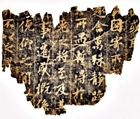Japanese Archaeology and Special Exhibition (Heiseikan) Thematic Exhibition Room
March 15, 2011 (Tue) - May 15, 2011 (Sun)
In ancient China, ink rubbing developed as a convenient method of making reproductions. The oldest surviving rubbing is Fountain Memory from the Tang dynasty, found in Cave 17 at Dunhuang, however the origin of ink rubbing is thought to date back to even earlier times. Very few ink rubbings from as early as the Tang dynasty survive today.
Stone inscriptions with historical importance are known as "steles." Steles often incorporate stately and orderly calligraphic styles such as seal script, clerical script, and regular script. Calligraphic models known as "copybooks," another category of inscriptions, were also engraved on wood and stone. The majority of these models were produced in styles used in everyday life, such as running and cursive scripts. In the Song dynasty, many high-quality types of paper and ink came to be manufactured, leading various techniques of ink rubbing to evolve. Rubbings produced using sophisticated techniques were highly admired by collectors for their prestige and beauty.
This year's annual joint project between Tokyo National Museum and the Taito City Calligraphy Museum focuses on renowned ink rubbings from China. Rubbings comprise the foundation of the study of calligraphy. As we extend our view to the stories behind them, this exhibition introduces the appeal of ink rubbings, along with stories of their owners and their transmission through history. We hope you enjoy the world of ink rubbings represented here through famed writings of Wang Xizhi and other masterpieces from Tang and Song China, the original inscriptions of which are now lost.

